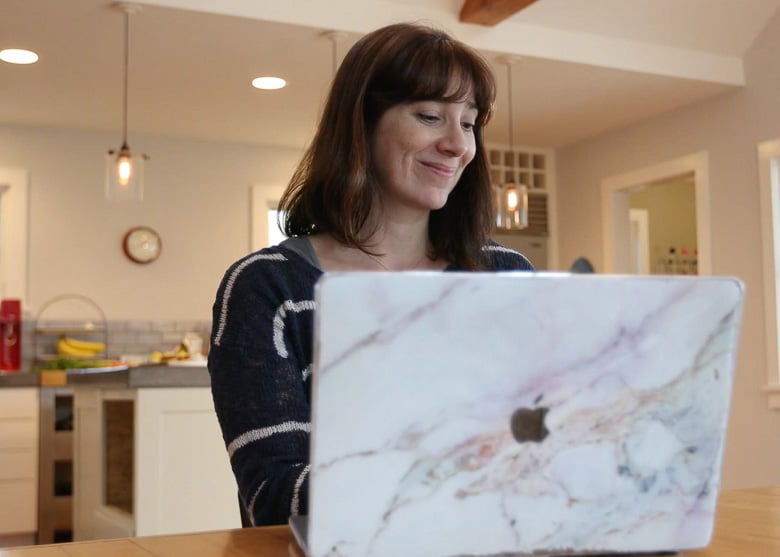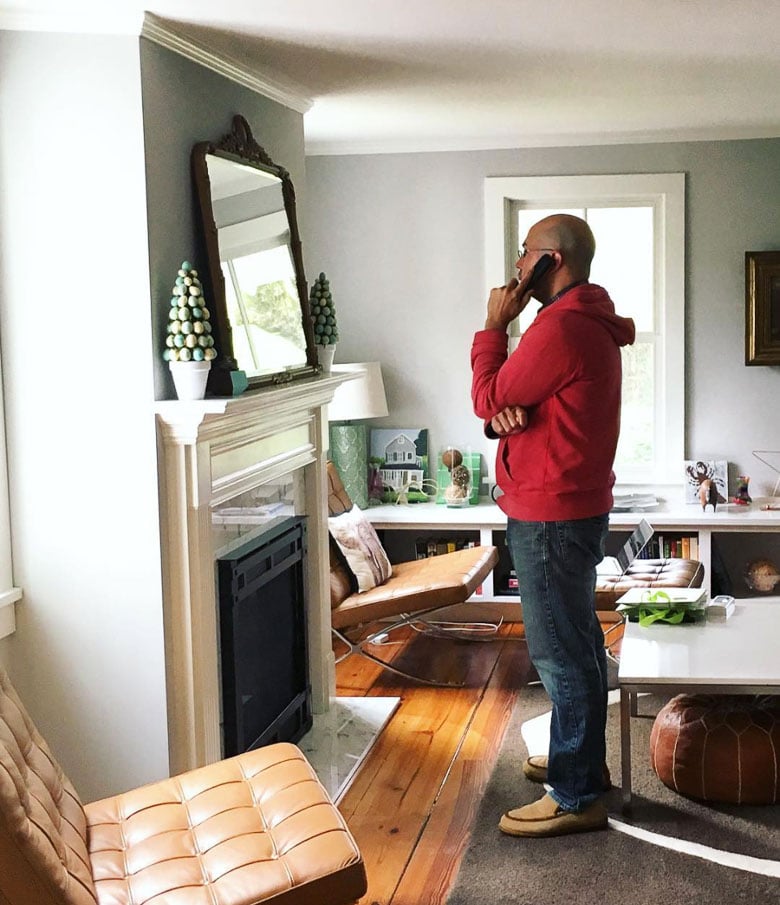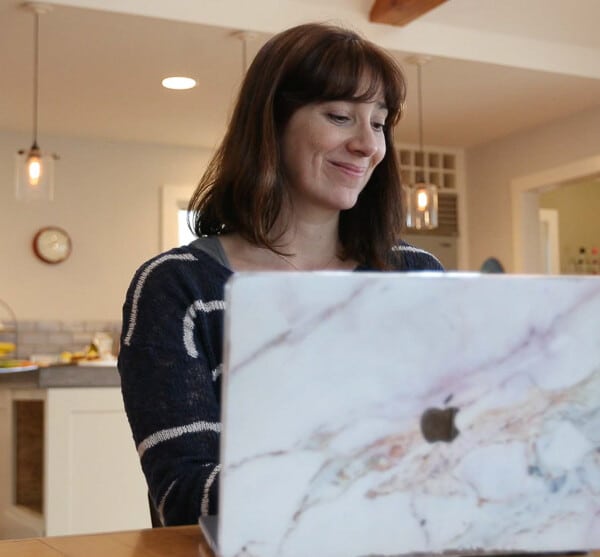This post may contain affiliate links. Learn more.
Editor’s note: Please welcome Rebecca Barson, a public policy expert with years of experience working from home with organizations big and small, and a longtime friend of Umami Girl. Rebecca shares next-level strategies and tactics for how to work from home successfully, whether in the short- or long term.

Table of Contents
My transition from office life to working at home
About six years ago, I went from a workspace in a shared cubicle in a bustling office in DC to a new job in New Jersey with a company where most of the administrative staff worked from home, and I was thrilled. There was a short adjustment period, but mostly I took to it like a fish to water.
Four years ago, when I started my own consulting firm and moved back to DC, there was no question that I would continue working from home. And these days it’s difficult to imagine having a job that would require me to work from a traditional office five days a week.
I was lucky. I was prepared and chose those situations — and both times, I’ve had a separate room as a home office and a comfortable desk and chair set up with a printer, scanner, and other necessary items.
But what should you do when you’ve been thrust into working from home on a few days’ notice (or none at all) due to a pandemic outbreak, particularly when you look for advice and so much of it seems unrealistic?
Tip for working from home: The philosophical side
I started thinking about what advice I would give my friends in this situation, based on what I’ve learned over the last six years. Here are my tips for working from home, whether it’s for a few weeks or a more long-term change.
Determine your most important boundaries
This first set of tips is more philosophical. A lot of work from home advice is really about establishing boundaries between work life and home life, as well as signaling to yourself that you are in work mode. This is good advice, but it’s also helpful to think about which boundaries are most important for you and where you may have some wiggle room that could make your experience more pleasant or enjoyable for you while still being productive.
- Getting dressed in work clothes vs. wearing comfortable clothes/pajamas: A lot of work from home advice will tell you that you absolutely should get dressed in work clothes or you will not feel like you are in work mode. This is likely the case for some people, but I believe in being comfortable and have been productively working from home for 6 years while wearing loungewear and dressing up a bit more while being on video calls.
- Strict start/end times vs. more flexibility: You may or may not have any input into this aspect of your work day, but if you do, it’s worth thinking about how strictly you want or need to hold yourself to specific start and end times to your day. One thing that I like about working from home is that I’m more able to follow my energy flow – so since I’m not a morning person, I will ease into my day, but will often have a super productive burst from about 4-7 pm.
- Eating lunch at your desk vs. stepping away: Again, a lot of advice will tell you it’s important to get up for lunch. I agree you should take some breaks during the day that involve leaving your desk/computer, but it doesn’t have to be for lunch. I often have a long leisurely breakfast and a shorter lunch at my desk but also may get out to take a short walk during the day. If public health recommendations allow for it, this will likely be a welcome break during all our indoor time over the next few to several weeks.
- Having a designated place to work vs. working in various different places: Particularly in small urban living spaces, you may not have a separate room or even a desk for working from home. You may at least be able to carve out a specific space at a kitchen or dining room table to designate for work or it may be more comfortable to relocate to different places during the day. While I am looser about other boundaries, I am fairly strict about confining work activities and materials to my home office (although I will answer short emails from my phone or tablet).
I recommend experimenting with each of these to see what works for you. What is necessary for you to feel like you are in work mode? What is necessary for you to feel like you are stepping away from work at the end of the day? There is no right answer — just what works for you.

Tips for working from home: The practical side
The rest of this article contains more concrete tips for staying organized and motivated and maintaining contact with other people as you work from home.
Keep yourself organized
- Maintain your usual organizational systems as much as possible: When we’re in an unusual situation, it’s easy for organization to go out the window. But if possible, try to maintain whatever organization you had in place for your work stuff before you had to work from home. If you don’t have all the tools for doing so, at least try to put everything you’re using right now into one or two physical or electronic folders to go through when you’re back in the office.
- Keep your work stuff contained: Whether or not you have a designated space for your work, it’s helpful to keep all the stuff that you need for work contained in some way. You can spread it out while you’re working, but put it all back in one place at the end of the day. I especially like these Multi-Purpose Bins from the Container Store in the small size as a place to put several folders and a notebook.
- Write everything down in one notebook: Keep all the notes that you might have written on different scraps of paper or sticky notes all in one place in a single notebook. (Or if you’ve gone paperless, keep them all in one running document on your computer.)
Keep yourself motivated
- Use the Pomodoro technique: I have found that forcing myself to start working on a task for 25 minutes is almost always enough time to get me deep enough into it that I will keep working on it. There are several apps based on this technique. I use FocusKeeper.
- Work with your energy: As mentioned above, I try to work with my energy and do projects that require more intensive focus at the end of the day when I know that my energy tends to be better suited for these types of tasks. You may not have this flexibility, but if you do, it can be very helpful to schedule your day this way.
- Focus on the positive: You may discover that you love working from home and may be able to make a case for being able to do so more frequently going forward. Or you may hate it and can feel good about it only being temporary.
Interact with other humans
- Use and embrace video technology: Many of us who work from home joke about hating video calls. But I have come to appreciate them. It is really nice to see other people’s faces and their expressions rather than only hearing their voices, and I suspect we will really value this kind of contact in the weeks to come.
- Have phone calls and text chains that don’t just focus on work: I know that phone calls are going out of fashion, but I really enjoy the phone calls that I have with colleagues, as well as the text chains. Mostly I appreciate that we have relationships with each other. Nurture these connections — we will need them now more than ever.
What about you?
So what are your tips for working from home, especially if you have kids? If you just started, what have you been finding helpful? Please share in the comments below.
About the author
Rebecca Barson lives in Washington, DC and owns RDB Strategies, a consulting firm dedicated to making good reproductive health care into public policy.












